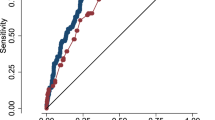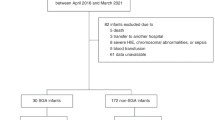Abstract
Objective:
We sought to determine whether, among very low-birth-weight (VLBW) neonates, the platelet mass was associated with common perinatal factors, and whether a low platelet mass in the first days following birth was associated with a higher incidence and/or severity of intraventricular hemorrhage (IVH).
Study Design:
This was a cross-sectional, retrospective cohort analysis of VLBW infants admitted to a level 3 neonatal intensive care unit from June 2003 to July 2006, n=408. Platelet mass was calculated and recorded on the day of birth and for 2 consecutive days thereafter. All neonates had a screening cranial sonogram on day 4 of life. Statistical analysis included analysis of variance and Mann–Whitney U-test.
Result:
Neonates born to mothers with pre-eclampsia had a smaller platelet mass (1921 fl/nl±603 vs 2297 fl/nl±747; P<0.01). The same was found among neonates with intrauterine growth restriction (IUGR). In contrast, neonates born after histological chorioamnionitis had a larger platelet mass (2400 fl/nl±749 vs 2036 fl/nl±674; P<0.01). No effect of platelet mass, measured on the day of birth, was observed related the outcomes of IVH, severe IVH or death. However, those with a platelet mass <10th percentile on the 2 subsequent days following birth were more likely to have severe IVH or death.
Conclusion:
Among VLBW neonates, pre-eclampsia and IUGR are associated with a lower platelet mass, owing to their effect on platelet count. Histological chorioamnionits is associated with a larger platelet mass. A mass <10th percentile on the days following birth was associated with severe IVH and/or death, but it remains unclear whether this is a cause of, or an effect of, the IVH.
This is a preview of subscription content, access via your institution
Access options
Subscribe to this journal
Receive 12 print issues and online access
$259.00 per year
only $21.58 per issue
Buy this article
- Purchase on Springer Link
- Instant access to full article PDF
Prices may be subject to local taxes which are calculated during checkout
Similar content being viewed by others
References
Sola MC, Del Vecchio A, Rimsza LM . Evaluation and treatment of thrombocytopenia in the neonatal intensive care unit. Clin Perinatol 2000; 27: 655–679.
Mehta P, Vasa R, Newman L, Karpatkin M . Thrombocytopenia in the high risk infant. J Pediatr 1980; 97: 791–794.
Castle V, Andrew M, Kelton JG, Carter C, Giron D, Johnston M . Frequency and mechanism of neonatal thrombocytopenia. J Pediatr 1986; 108: 749–755.
Christensen RD, Henry E, Wiedmeier SE, Stoddard RA, Sola-Visner MC, Lambert DK, Kiehn TI, Ainsworth S . Thrombocytopenia among extremely low birth weight neonates: data from multihospital healthcare system. J Perinatol 2006; 26: 348–353.
Mohr R, Martinowitz U, Golan M, Ayala L, Goor DA, Ramot B . Platelet size and mass as an indicator for platelet transfusion after cardiopulmonary bypass. Circulation 1986; 74 (5 part 2): III153–III158.
Papile LA, Burstein R, Koffler H . Incidence and evolution of subependymal and intraventricular hemorrhage: a study of infants with birth weights less than 1,500 gm. J Pediatr 1978; 92: 529–534.
ACOG Committee on Obstetric Practice, ACOG practice bulleting. Diagnosis and management of preeclampsia and eclampsia. Number 33, January 2002, American College of Obstetricians and Gynecologists. Int J Gynaecol Obstet 2002; 33 (77): 67–75.
Beiner ME, Simchen MJ, Sivan E, Chetrit A, Kuint J, Schiff E . Risk factors for neonatal thrombocytopenia in preterm infants. Am J Perinatol 2003; 20 (1): 49–52.
Roberts I, Murray NA . Neonatal thrombocytopenia: causes and management. Arch Dis Chil Fetal Neonatal Ed 2003; 88: 359–364.
Mondanlou HD, Oriz OB . Thrombocytopenia in neonatal infection. Clin Pediatr (Phlia) 1981; 20: 402–407.
Storm W . Use of thrombocytopenia for the early identification of sepsis in critically ill newborns. Acta Pediatr Acad Sci Hung 1982; 23: 349–355.
Guida J, Kunig A, Leef K, McKenzie S, Paul D . Platelet count and sepsis in very low birth weight neonates: is there an organism specific response? Pediatrics 2003; 111: 1411–1415.
O’Connor TA, Ringer KM, Gaddis ML . Mean platelet volume during coagulase negative staphylococcal sepsis in neonates. Am J Clin Pathol 1993; 99: 69–71.
Andrew M, Castle V, Saigal S, Carter C, Kelton JG . Clinical impact of neonatal thrombocytopenia. J Pediatr 1987; 110: 457–464.
Andrew M, Vegh P, Caco C, Kirplani H, Jefferies A, Ohlsson A, Wang E et al. A randomized control trial of platelet transfusions in thrombocytopenic premature infants. J Pediatr 1993; 123: 285–291.
Michalak E, Walkowiak B, Paradowski M, Cierniewski CS . The decreased circulating platelet mass and its relation to bleeding time in chronic renal failure. Thromb Haemost 1991; 65 (1): 11–14.
Del Vecchio A, Sola MC, Theriaque DW, Hutson AD, Kao KJ, Christnensen RD et al. Platelet transfusions in the neonatal intensive care unit: factors predicting which patients will require multiple transfusions. Transfusion 2001; 41: 803–808.
Garcia M, Duenas E, Sola MC, Hutson AD, Theriaque D, Christensen RD . Epidemiologic outcomes studies of patients who received platelet transfusions in the neonatal intensive care unit. J Perinatol 2001; 21: 415–420.
Baer VL, Lambert DK, Henry E, Snow GL, Sola-Visner MC, Christensen RD . Do platelet transfusions in the NICU adversely affect survival? Analysis of 1600 thrombocytopenic neonates in multihospital healthcare system. J Perinatol 2007; 27: 790–796.
Gerday E, Baer VL, Lambert DK, Paul DA, Sola-Visner MC, Pysher TJ, Christensen RD . Testing platelet mass versus platelet count to guide platelet transfusions in the neonatal intensive care unit. Transfusion 2009; 49 (10): 2034–2039.
Christensen RD, Paul DA, Sola-Visner MC, Baer VL . Improving platelet transfusion practices in the neonatal intensive care unit. Transfusion 2008; 48 (11): 2281–2284.
Author information
Authors and Affiliations
Corresponding author
Ethics declarations
Competing interests
The authors declare no conflict of interest.
Rights and permissions
About this article
Cite this article
Zisk, J., Mackley, A., Christensen, R. et al. Is a small platelet mass associated with intraventricular hemorrhage in very low-birth-weight infants?. J Perinatol 31, 776–779 (2011). https://doi.org/10.1038/jp.2011.32
Received:
Revised:
Accepted:
Published:
Issue Date:
DOI: https://doi.org/10.1038/jp.2011.32



